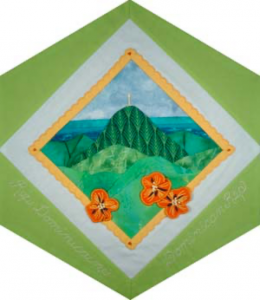Dominican Republic

The Block
An island of sun and sand, and strong people who enjoy colour, their environment and their luxurious natural surroundings are characteristics of the Dominican Republic conveyed in this block. Blockmaker Ann Dawes artfully folded and positioned a variety of coloured cottons to recreate the nation’s coastline. It is said that the beautiful beaches inspired Columbus to remark, “There is no more beautiful island in the world.” In the foreground stands the Pico Duarte––part of the Cordillera Central mountain range that occupies a large portion of the Dominican Republic’s central interior. At 3,087 metres it is the tallest peak in the Caribbean. Resting on the crest of the mountain is the statue that crowns the Monument of the Heroes of the Restoration, a 67-metre (220 ft), white marble structure housing the murals of Spanish artist, Vela Zanetti. Lush, three-dimensional petals of the flor de la caob, declared the national plant by presidential decree, are stitched at the base of the mountain.
Cultural Profile
The Dominican Republic (second largest island in the Caribbean) occupies two-thirds of the island known as Hispaniola (La Isla Española), which was discovered and named by Christopher Columbus in 1492. The capital, Santo Domingo, is the oldest city in the New World and home to the oldest street, cathedral, house, university and the first hospital (built in 1503, now the San Nicolas de Bari Ruins) in the Americas. Lake Enriquillo, the only salt water lake in the world inhabited by crocodiles, is also located in the Dominican Republic.
The major ethnic groups are Mulatto (mixture of European, African and Taino indigenous people), European and African. There are also many immigrants from neighboring Haïti, a country that shares the island of Hispaniola with the Dominican Republic. This has been a cause for tension between the two groups recent years.
Spanish is the official language and the mother tongue of most native Dominicans, with many words coming from the Arawak/Taino language of the first inhabitants of the island. Dominicans often speak very quickly and loudly, using bold gestures, a cultural custom that can sometimes be misconstrued by outsiders.
Music and dance are at the heart of Dominican culture. Merengue, a popular dance and favourite type of music played and enjoyed by all ages, is celebrated in an annual week-long Merengue Festival in July.
Architecture is another important part of the culture, from colonial Spanish buildings in Santo Domingo to brightly coloured farmhouses in the countryside. The wood from the West Indies Mahogany tree, native to the island, has been used extensively first by the Taino, then by the Spanish, to build churches and houses. An example of this can be seen in Santo Domingo’s Cathedral de Santa María la Menor, which dates back to 1514.
The Dominican Republic possesses one of the largest reserves of amber, known as ‘touchstone’ because of its static qualities. The amber sometimes shows a special blue coloration when displayed under sunlight. This phenomenon is similar to the effect that makes the sea look blue to our eyes. It is the only place in the world that mines larimar (Dominican Turquoise of a cloudy light blue that eventually fades if exposed to sunlight and heat). The Domicans are known for their hand-crafted jewelry made with both of these semi-precious stones.
Other crafts include mahogany woodcarving, tortoiseshell work, woven baskets, ceramics such as the faceless dolls, and macramé hammocks and bags. Thanks to its tropical climate which makes it a perfect place to grow tobacco, the country produces hand-rolled cigars.
Dominicans have a deep love for baseball, the pelotas, which they share with Cuba, Puerto Rico and the United States. The country is indeed a powerhouse in the sport, consistently winning world titles. It is home to many Major League Baseball players.
As a result of economic problems, many Dominicans have come to Canada in search of a more stable life. The 2011 census reports almost 16,000 Dominicans now living here, many of whom have settled in Ontario or Québec. They have been an influence in many areas of Canadian life including music and cuisine. By establishing clubs and restaurants such as the ‘Punta Cana Nightclub’, ‘Restaurant Sosua’ (in Montréal), and ‘The Friendly Dominican’ (in Toronto), they have allowed many Canadians to sample their unique culture.
Sponsor: Knowledge Flow Corporation
